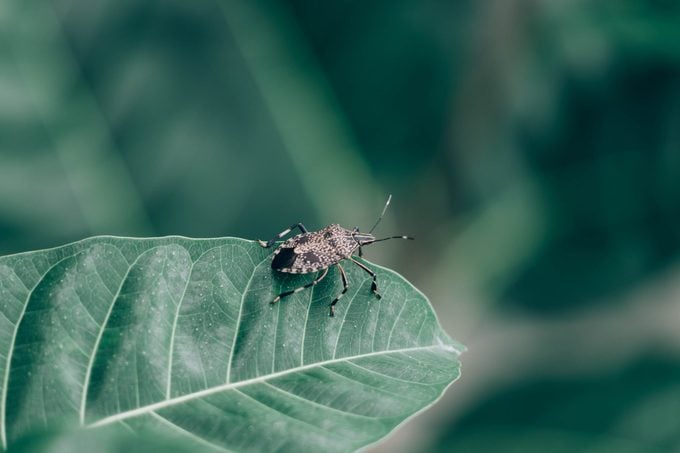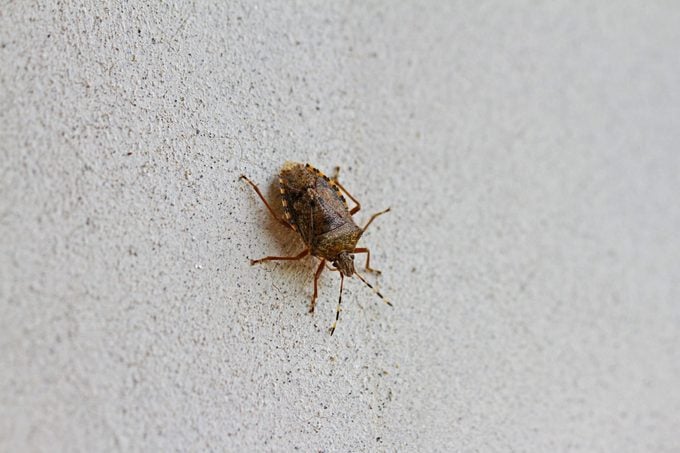How to Get Rid of Stink Bugs
Updated: Mar. 29, 2022
Stink bugs are shriek-worthy foes—whether they fall off the ceiling and drop on your head or leave their pungent odor behind.
What do stink bugs look like?
The most common stink bug in the United States is the brown marmorated. As the name implies, it’s brownish in color, similar to the colors of a tree trunk and its shape resembles a tiny shield. They’re about 3/4 inches in length and width and the adults can fly but you don’t notice their wings unless you see them in action as the wings are neatly folded close to their body. In the early stages of their life, they’re actually a reddish black color but each time they molt, they grow a little larger, a similar life cycle as a bed bug’s.
Why do stink bugs stink?
Stink bugs don’t stink all the time. The only time you’ll smell them is when they feel threatened or meet an untimely demise via us squishing them. That pungent odor is part of their defense against predators, like birds and humans. The stinky chemical comes from a gland in their abdomen and some stink bug species can spray the chemical several inches. Some people compare the odor to a skunk and others smell cilantro, which makes sense because the National Pest Management Association says the odor contains chemicals commonly used as food additives and is present in cilantro.
When are stink bugs active?
If you want to know how to get rid of stink bugs, it’s helpful to know they’re seasonal. Stink bugs lay low during the winter months and hide out in buildings or homes, in the walls, crawl space, attic or even in a bookcase or under a bed. Thankfully, they don’t cause damage or reproduce in your house. But once the warm weather hits, they’re active again. “Stink bugs will turn up on sunny sides of homes where they warm themselves,” says Jim Fredericks, PhD, chief entomologist and vice president of technical and regulatory affairs for the National Pest Management Association. Springtime to early fall is prime time for feeding, mating, and reproducing.
Do stink bugs bite?
Stink bugs have mouthparts that could pierce our skin and suck our blood, but they’re not into humans at all. They’re not likely to bite (and can’t sting) and they don’t spread disease or cause structural damage but they can take a toll on your back yard. They pierce and suck the juice from the leaves, stems, and plant roots, including those pretty ornamental shrubs. They’re also a real threat to growers, Fredericks says because of the damage they cause to the crops, especially orchard fruits. “Growers often detect an infestation by the damage they cause to their crops, especially orchard fruits,” says Fredericks. Some insects do use their mouthparts to pierce human skin.
How to get rid of stink bugs in your house
We know, you just want to squish them and be done with them, but don’t or you’ll instantly regret it. “When disturbed or crushed, stink bugs have a tendency to release a bad-smelling, bad-tasting odor from pores on the sides of their bodies,” notes Fredericks—and it can linger for hours. Haul out the vacuum and suck them up instead. Empty the vacuum bag or container in the trash and place it outside or use an old sock around the attachment and dispose of it in the outside trash. If a stink bug sprayed, these homemade deodorizers help make your house smell fresh again.
Seal entry points
Stink bugs are large enough to spot crawling or flying in your home but they’re still small enough to sneak in your house. “Typical entry points include around door and window frames, sedges of siding, flashing and vents. Use a good quality silicone or silicone-latex caulk to seal cracks,” says Fredericks. Don’t forget to check window and door screens too when you’re figuring out how to get rid of stink bugs.
 Cut the lights
Cut the lights
If you can see daylight through the cracks around the door so will a stink bug—as an open invitation. So, how to get rid of stink bugs? Weatherstrip doors or install door sweeps to keep them from sneaking in. And outdoor lights at night attract stink bugs like a neon vacancy sign, so Fredericks recommends keeping outdoor lighting to a minimum. “During the evenings, turn off porch lights and pull down window blinds to prevent light from spilling outside.”
Secure the perimeter of your house
Cracks in the foundation are an easy access point for lots of pests, including stink bugs. Inspect for cracks and seal them up. Don’t forget crawlspace entries too. And take a closer look at any exposed plumbing and seal the smaller gaps with chalk and use steel wool for the larger gaps. Here are 13 other things that could be attracting pests to your house right now.
Clean up yard debris
Stink bugs love a sunny side of a building but they also congregate in leaf litter and edible debris just outside your back door. And not just in cozy numbers of ten or 12. According to the EPA, stink bugs in established areas from debris and vegetation near the house can enter in by the hundreds. Rake all debris near the house to discourage them from flying inside—especially when the temperatures start to drop and they’re searching for warm places to hide out for the winter. Keep an eye for these 11 pests who could be hiding in your attic.
Check these items before you come inside
Keep your eyes out for stink bugs trying to hitchhike in your home. They can travel on anything like tote bags, toys, or garden gloves, and decide to stay inside. Or if you’re bringing in decorative porch or patio items to clean or store, check those too before crossing the door threshold. Bed bugs are known hitchhikers too, but they’re much smaller than stink bugs and not easy to see.
Don’t waste your money on bug sprays
Reaching for a can of bug spray is easy and convenient but the insecticide will only kill the stink bugs you can see, not the stink bugs that are hiding out of sight. They’ll just crawl or fly out later when the threat has subsided and resume life as usual. If you notice more than a couple of stink bugs and worried about an infestation, Fredericks suggests calling a licensed stink bug control professional to evaluate and asses the severity of the problem. The pros can also assist you in identifying the access points you might be missing.

